Scientists Have Found An Alternate Earth
An alien planet orbiting Red Dwarf Star Wolf 1069 appears to have remarkable similarities to Earth.
This article is more than 2 years old

A team of scientists has found an Earth-sized alien planet about 31 light-years away in the Cygnus constellation. Since it orbits the habitable zone of a Red Dwarf Star Wolf 1069 where liquid water can exist, scientists are excited to explore it for signs of extraterrestrial life. Although its rotation is probably tidally locked, which means only portions of the dayside could be habitable, the team is still optimistic.
Speaking to Futurism about the discovery, Diana Kossakowski, Max Planck Institute for Astronomy (MPIA) astronomer and lead author of a paper published in the journal Astronomy & Astrophysics said the team discovered a clear, low-amplitude signal of what appears to be an alien planet of roughly Earth-mass within the data analysis.
Kossakowski said the alien planet orbits the star within 15.6 days at a distance equivalent to one-fifteenth of the separation between the Earth and the Sun. While it may provide durable habitable conditions across a wide area of its dayside, conditions for life on the rocky planet aren’t nearly as balmy as our home planet.
The alien planet only receives radiation of 65% from its star compared to the volume Earth gets from the Sun. That means its surface is probably a lot cooler. The absence of any stellar activity or intense UV radiation increases the chances that Wolf 1069 could have retained much of its atmosphere, the paper says. That makes the planet very promising in terms of habitability markers and biosignatures.

If the alien planet is mostly made up of bare rock, temperatures could average around -9 degrees Fahrenheit. But if it has an Earth-like atmosphere, temperatures might a high but extremely livable 55 degrees Fahrenheit. Still, there’s no guarantee that it actually has an atmosphere as Red Dwarfs are particularly violent hosts.
That means the alien planet could easily wreak havoc on any planet trapped in its orbit. Despite these concerns, Kossakowski believes that further exploration will be beneficial. “Our computer simulations show that about 5% of all evolving planetary systems around low-mass stars, such as Wolf 1069, end up with a single detectable planet,” study co-author Remo Burn said via Futurism.
Distance is another factor that makes exploration of the alien planet difficult. While 31 light-years is not an unsurpassable distance, developing the technologies to search for biosignatures will be quite challenging. “We’ll probably have to wait another 10 years,” Kossakowski added. She also noted that it’s crucial to develop equipment since potentially habitable worlds are detected via the RV method only.
“Wolf 1069 is a noteworthy discovery that will allow further exploration into the habitability of Earth-mass planets around M dwarfs, as well as a case study in testing planetary formation theories,” the study concluded. The team plans to continue searching for other alien planets that may be close by.
Interestingly, Wolf 1069 isn’t the first seemingly habitable alien planet discovered by scientists. In 2016, astronomers detected exoplanets near the Proxima Centauri star system. Dubbed Proxima Centauri b, the planet is just a little bigger than Earth and orbits the red dwarf in its habitable zone, Universe Today reports. But Proxima Centauri is a flare star which means the habitable zone is not habitable at all.











